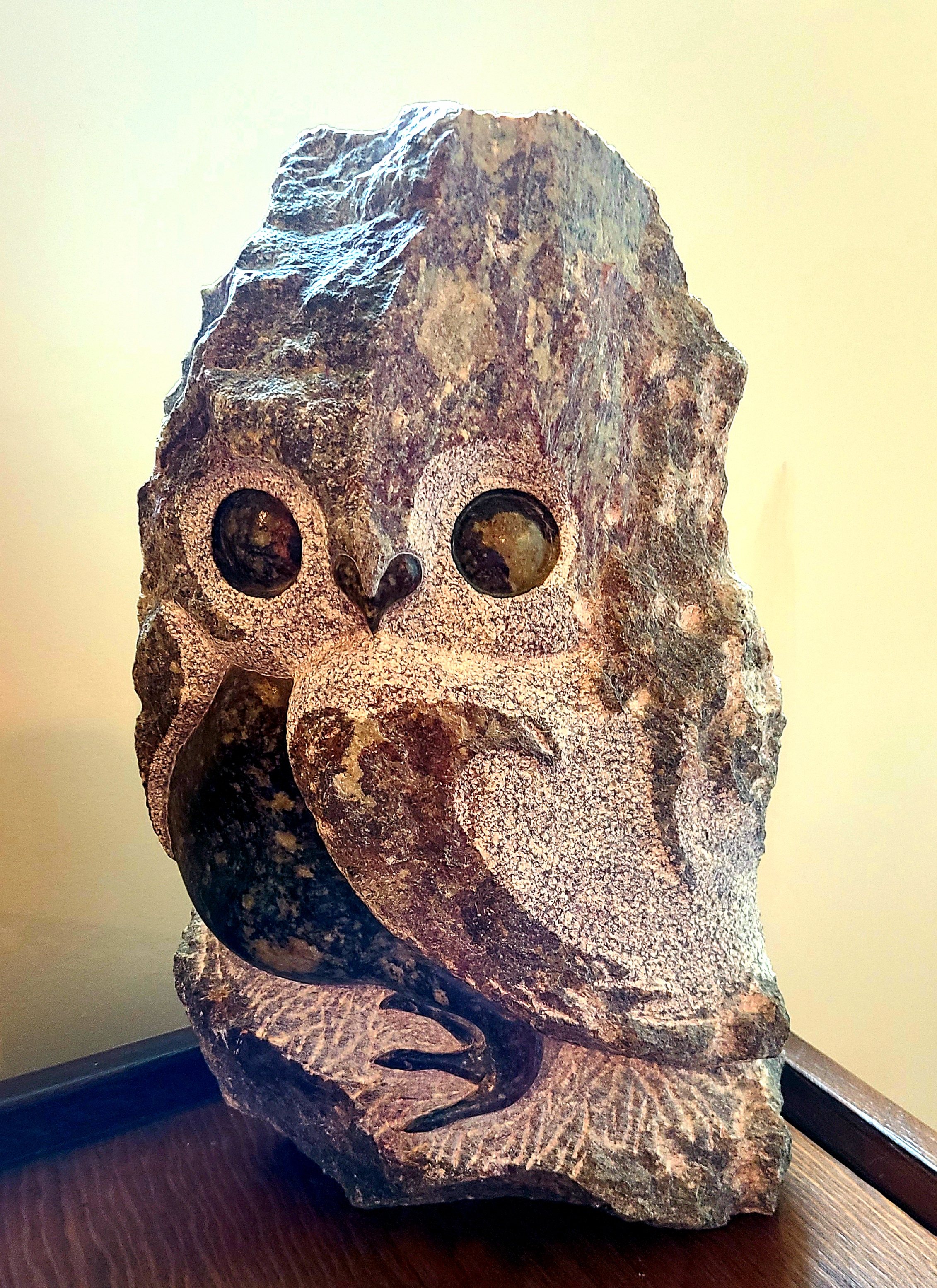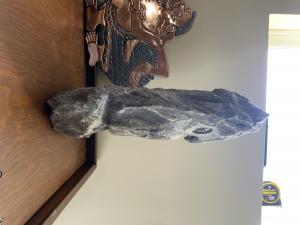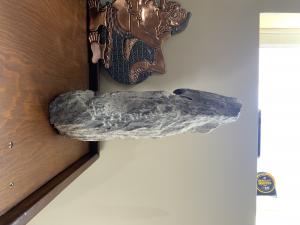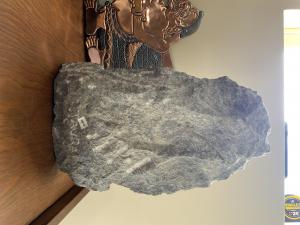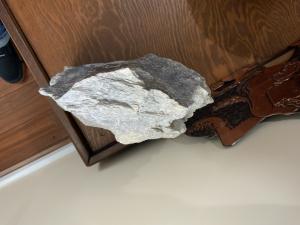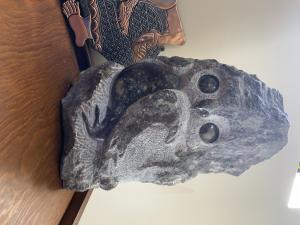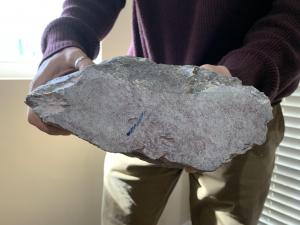Fluffing My Feathers
Taurai Mupaso
Sculpture
Another owl sculpture by Taurai Mupaso. Here, the original shape of the stone is most distinct as large areas (the very top, bottom, also the sides) were left completely unworked and unpolished, while others were worked/carved only slightly (the body of the owl, the feathers), only as much as was needed to pronounce the animal form. In part, this is probably due to the difficult nature of working with cobalt stone, but Taurai’s works generally seem to focus more on imaginative ways of bringing the animals shapes to light out of the original form of stones with a minimum amount of deep carving. In some places, such as the feathers or the bottom part where we see the feet of the owl standing on a veiny surface, one can almost not tell whether the stone had been worked on because the shapes seem so natural. They most certainly were, but Taurai really displays an amazing level of skill here, blending organic and artificial forms so seamlessly, to the point where at first glance, one might think that only the polished surfaces where the cobalt stone is most visible - the eyes, the beak and the stomach of the owl - had been worked on.
In African tradition and spirituality, owls are associated with witchcraft and are thought to bring evil and death and as a result, people attack and kill them wherever they are seen in broad daylight. Owls were also the biggest childhood fear of Taurai, a fear which he conquered through carving these sculpture. Nowadays, he wants to shift the cultural misunderstanding for these nocturnal birds, so he portrays them as friendly, almost mythical, characters that evoke sympathy rather than fear and antagonism.
In African tradition and spirituality, owls are associated with witchcraft and are thought to bring evil and death and as a result, people attack and kill them wherever they are seen in broad daylight. Owls were also the biggest childhood fear of Taurai, a fear which he conquered through carving these sculpture. Nowadays, he wants to shift the cultural misunderstanding for these nocturnal birds, so he portrays them as friendly, almost mythical, characters that evoke sympathy rather than fear and antagonism.
Taurai is part of a group of crafters who curve sculptures out of stone to create a unique art form praised to be perhaps the most important new art form to emerge from Africa this century.” (https://www.latimes.com/archives/la-xpm-1993-10-03-tr-41822-story.html )
Taurai’s predecessors are first generation masters like Takawira, Mteki, Mukomberanwa, Munyaradzi and Masaya. Collectors of Shona sculpture include the Rockefellers, England’s Royal Family, the Rothschilds, the New York Museum of Modern Art and the Rodin Museum in Paris. https://www.latimes.com/archives/la-xpm-1993-10-03-tr-41822-story.html
At the higher end, a large sculpture by an established master may sell for about $10,000, although Shona pieces have been priced at up to $50,000 in the United States.
A few of the established masters of Shona stone sculpture are reputed to earn as much as $250,000 a year but most earn far less. One master artist, Richard Mteki, whose earnings are at the high end, reportedly supports an extended family of 65 members with his sculpture. https://www.latimes.com/archives/la-xpm-1993-10-03-tr-41822-story.html
*SHONA SCULPTURE.
Stone carving has been a part of Zimbabwean culture since the 1200s and re-emerged as a modern sculptural tradition in the 1950s, known as the “Shona movement”. The driving force behind this art renaissance was Frank McEwen, director of the Rhodesia National Gallery from 1957 to 1973. McEwen encouraged and supported aspiring artists as they started the movement that would quickly become world-renowned. International collectors and critics were amazed at the rigour, spontaneity and originality of the works coming from an area of Africa which had none of the great sculptural heritage of West Africa and had been previously described as rather barren in terms of its visual arts. Contrary to other artistic tendencies and movements coming out of Africa in the post-colonial period, Shona sculptures were not looking back at the tradition of functional sculptural objects inspired by traditional customs and rituals, rather they found their sources in the present and created sculptures that blend the contemporary moment with the memories and dreams of their tribal past - the so-called “tribal consciousness” that was thematically encouraged by McEwen, alongside more modernist expressionist tendencies. Up to today, artists, without preliminary studies, spontaneously carve out semi-abstract shapes of birds and other animal or human forms imbued with ancestral symbolism, expressing an integral part of present day Shona folklore and religious beliefs.
Taurai’s predecessors are first generation masters like Takawira, Mteki, Mukomberanwa, Munyaradzi and Masaya. Collectors of Shona sculpture include the Rockefellers, England’s Royal Family, the Rothschilds, the New York Museum of Modern Art and the Rodin Museum in Paris. https://www.latimes.com/archives/la-xpm-1993-10-03-tr-41822-story.html
At the higher end, a large sculpture by an established master may sell for about $10,000, although Shona pieces have been priced at up to $50,000 in the United States.
A few of the established masters of Shona stone sculpture are reputed to earn as much as $250,000 a year but most earn far less. One master artist, Richard Mteki, whose earnings are at the high end, reportedly supports an extended family of 65 members with his sculpture. https://www.latimes.com/archives/la-xpm-1993-10-03-tr-41822-story.html
*SHONA SCULPTURE.
Stone carving has been a part of Zimbabwean culture since the 1200s and re-emerged as a modern sculptural tradition in the 1950s, known as the “Shona movement”. The driving force behind this art renaissance was Frank McEwen, director of the Rhodesia National Gallery from 1957 to 1973. McEwen encouraged and supported aspiring artists as they started the movement that would quickly become world-renowned. International collectors and critics were amazed at the rigour, spontaneity and originality of the works coming from an area of Africa which had none of the great sculptural heritage of West Africa and had been previously described as rather barren in terms of its visual arts. Contrary to other artistic tendencies and movements coming out of Africa in the post-colonial period, Shona sculptures were not looking back at the tradition of functional sculptural objects inspired by traditional customs and rituals, rather they found their sources in the present and created sculptures that blend the contemporary moment with the memories and dreams of their tribal past - the so-called “tribal consciousness” that was thematically encouraged by McEwen, alongside more modernist expressionist tendencies. Up to today, artists, without preliminary studies, spontaneously carve out semi-abstract shapes of birds and other animal or human forms imbued with ancestral symbolism, expressing an integral part of present day Shona folklore and religious beliefs.
Height: 16
Width: 10
Depth: 4
inches
Phoenix, AZ
Chitungwiza Arts center (C.A.C) in Zenga 4 Zimbabwe.
*Material: This sculpture is carved out of cobalt sone, a beautiful variety of serpentine stone that is often purple or green with variations of yellow and white or brown/orange markings and stripes throughout. Cobalt is a relatively hard metal that closely resembles iron and nickel in appearance. It is quite fragile and relatively rare, making it quite a challenging stone to work with, however, for sculptors who have the necessary skill, the bright colour and the variety of textures can allow for the production of stunning works. It is mined in the Chiweshe area of northern Zimbabwe.
*Technique: Shona sculptures are made strictly with hand, no power tools are used at any stage of the process and generally, everything is created free-form, ie. there are no preliminary sketches. The tools consist of hammers, points, chisels, rasps and chasing hammers, and the finishing of each sculpture takes almost as long as the process of creating it. The smooth effect is achieved by “washing” the sculpture, using wet and dry sandpaper and if the artist wants a high polish on the stone, the stone is heated and covered with wax (for a more detailed description of the sculpting process, see ID 48)
Taurai is a young stone sculptor based at Chitungwiza Arts center (C.A.C) in Zenga 4 Zimbabwe. His forte is sculpting Owl figures. Through his unique figurines, Taurai has carved a niche for himself in the local visual arts industry and earned himself the nickname “Owl-man”.
He says:
Taurai is a young stone sculptor based at Chitungwiza Arts Centre (C.A.C) in Zengeza 4. His forte’ and passion is sculpting Owl figures! Many of which adorn his workshop.
Owls, being nocturnal birds are associated with witchcraft in the African tradition and are despised and feared by many Africans who regard them as harbingers of evil and death. Their large luminous eyes and eerie cries seem to lend credence to these suspicions. As a result people attack and kill these beautiful birds wherever they are seen in broad daylight.
Taurai seeks to demystify these misunderstood creatures by portraying them as friendly mythical characters in his sculptures evoking sympathy for these birds of the night.
Lack of access to international markets is Taurais biggest problem. “Locals appreciate my art but most cannot afford to buy luxuries like sculpture due to lack of disposable income” he said. Through his unique figurines, Taurai has carved a niche for him-self in the local visual arts industry and earned himself the nickname “Owl-man”.
